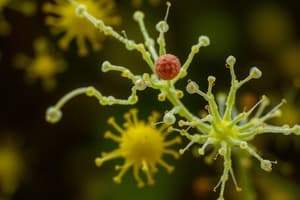Podcast
Questions and Answers
Which group of bacteria is known for producing methane as a waste product?
Which group of bacteria is known for producing methane as a waste product?
- Methanogens (correct)
- Unicellular bacteria
- Extreme thermophiles
- Extreme halophiles
What substance primarily composes the cell walls of true fungi?
What substance primarily composes the cell walls of true fungi?
- Peptidoglycan
- Cellulose
- Keratin
- Chitin (correct)
What movement structure do protozoa like amoebae use to move?
What movement structure do protozoa like amoebae use to move?
- Filaments
- Flagella
- Pseudopods (correct)
- Cilia
In which type of environment would you typically find extreme halophiles?
In which type of environment would you typically find extreme halophiles?
How do fungi obtain nourishment?
How do fungi obtain nourishment?
What is a characteristic feature of slime molds?
What is a characteristic feature of slime molds?
Which of the following is NOT a common method of movement for protozoa?
Which of the following is NOT a common method of movement for protozoa?
What type of cell structure characterizes eukaryotes, including fungi and protozoa?
What type of cell structure characterizes eukaryotes, including fungi and protozoa?
What process did Pasteur develop to prevent spoilage in wine and beer?
What process did Pasteur develop to prevent spoilage in wine and beer?
What was the main cause of souring in wine and beer as discovered by Pasteur?
What was the main cause of souring in wine and beer as discovered by Pasteur?
Before Pasteur's work, how were effective treatments for diseases commonly discovered?
Before Pasteur's work, how were effective treatments for diseases commonly discovered?
What concept explains the relationship between microorganisms and the causes of many diseases?
What concept explains the relationship between microorganisms and the causes of many diseases?
What misconception about disease did people hold before the acceptance of germ theory?
What misconception about disease did people hold before the acceptance of germ theory?
During Pasteur's time, what was one believed cause of disease apart from microorganisms?
During Pasteur's time, what was one believed cause of disease apart from microorganisms?
What role do yeasts play in the fermentation process identified by Pasteur?
What role do yeasts play in the fermentation process identified by Pasteur?
What was Pasteur's initial motivation for studying fermentation and spoilage?
What was Pasteur's initial motivation for studying fermentation and spoilage?
What did Pasteur's unique flask design achieve?
What did Pasteur's unique flask design achieve?
What is a major consequence of Pasteur's discoveries regarding microbial life?
What is a major consequence of Pasteur's discoveries regarding microbial life?
Which statement about aseptic techniques is true?
Which statement about aseptic techniques is true?
What was disproven by Pasteur's experiments regarding spontaneous generation?
What was disproven by Pasteur's experiments regarding spontaneous generation?
What time period is referred to as the Golden Age of Microbiology?
What time period is referred to as the Golden Age of Microbiology?
Which of the following advancements occurred during the Golden Age of Microbiology?
Which of the following advancements occurred during the Golden Age of Microbiology?
What aspect of microbiology was significantly improved during the Golden Age?
What aspect of microbiology was significantly improved during the Golden Age?
What role did immunity play according to microbiologists during the Golden Age?
What role did immunity play according to microbiologists during the Golden Age?
What did John Needham attribute the presence of microorganisms in nutrient fluids to?
What did John Needham attribute the presence of microorganisms in nutrient fluids to?
What was Lazzaro Spallanzani's contribution to the debate on spontaneous generation?
What was Lazzaro Spallanzani's contribution to the debate on spontaneous generation?
Which scientist proposed the concept of biogenesis in opposition to spontaneous generation?
Which scientist proposed the concept of biogenesis in opposition to spontaneous generation?
What experiment did Louis Pasteur conduct to demonstrate his findings about microorganisms?
What experiment did Louis Pasteur conduct to demonstrate his findings about microorganisms?
What was one criticism of Spallanzani's experiments regarding microbial growth?
What was one criticism of Spallanzani's experiments regarding microbial growth?
What did Anton Laurent Lavoisier demonstrate that contributed to the understanding of life?
What did Anton Laurent Lavoisier demonstrate that contributed to the understanding of life?
What was the primary conclusion of Louis Pasteur's experiments?
What was the primary conclusion of Louis Pasteur's experiments?
What aspect of Needham's findings eventually led to the theory of biogenesis?
What aspect of Needham's findings eventually led to the theory of biogenesis?
What enzyme does MRSA produce that destroys β-lactam antibiotics?
What enzyme does MRSA produce that destroys β-lactam antibiotics?
In which region was West Nile encephalitis first diagnosed?
In which region was West Nile encephalitis first diagnosed?
What is the primary vector for the transmission of the West Nile virus?
What is the primary vector for the transmission of the West Nile virus?
What infectious agent is responsible for bovine spongiform encephalopathy?
What infectious agent is responsible for bovine spongiform encephalopathy?
What significant public health issue was associated with E. coli O157:H7?
What significant public health issue was associated with E. coli O157:H7?
Which of the following statements about Creutzfeldt-Jakob disease (CJD) is true?
Which of the following statements about Creutzfeldt-Jakob disease (CJD) is true?
What was a common source of infection for cattle leading to the BSE epidemic?
What was a common source of infection for cattle leading to the BSE epidemic?
How did the West Nile virus first appear in North America?
How did the West Nile virus first appear in North America?
What was the primary objective of Edward Jenner's experiment?
What was the primary objective of Edward Jenner's experiment?
Which characteristic of the fowl cholera bacterium did Pasteur discover?
Which characteristic of the fowl cholera bacterium did Pasteur discover?
What term describes the protection from disease gained through vaccination or recovery from the disease?
What term describes the protection from disease gained through vaccination or recovery from the disease?
What was the initial discovery that led to Jenner's successful vaccination against smallpox?
What was the initial discovery that led to Jenner's successful vaccination against smallpox?
What is meant by the term 'avirulent' in the context of Pasteur's findings?
What is meant by the term 'avirulent' in the context of Pasteur's findings?
What significant role did Edward Jenner's experiment play in the field of microbiology?
What significant role did Edward Jenner's experiment play in the field of microbiology?
Which disease was eradicated largely due to vaccination techniques pioneered by Jenner?
Which disease was eradicated largely due to vaccination techniques pioneered by Jenner?
What does the word 'vacca', the root of the term vaccination, refer to?
What does the word 'vacca', the root of the term vaccination, refer to?
Flashcards
Chemoautotroph
Chemoautotroph
Bacteria that obtain nutrients from inorganic substances.
Photoautotrophic bacteria
Photoautotrophic bacteria
A type of bacteria that can produce their own food through photosynthesis.
Archaea
Archaea
Prokaryotic organisms that lack peptidoglycan in their cell walls and are often found in extreme environments.
Methanogens
Methanogens
Signup and view all the flashcards
Extreme halophiles
Extreme halophiles
Signup and view all the flashcards
Extreme thermophiles
Extreme thermophiles
Signup and view all the flashcards
Fungi
Fungi
Signup and view all the flashcards
Yeasts
Yeasts
Signup and view all the flashcards
Spontaneous Generation
Spontaneous Generation
Signup and view all the flashcards
Needham's Experiment
Needham's Experiment
Signup and view all the flashcards
Spallanzani's Experiment
Spallanzani's Experiment
Signup and view all the flashcards
Biogenesis
Biogenesis
Signup and view all the flashcards
Pasteur's Experiment
Pasteur's Experiment
Signup and view all the flashcards
Abiogenesis
Abiogenesis
Signup and view all the flashcards
Vital Force
Vital Force
Signup and view all the flashcards
Nutrient Broth
Nutrient Broth
Signup and view all the flashcards
Fermentation
Fermentation
Signup and view all the flashcards
Pasteurization
Pasteurization
Signup and view all the flashcards
Germ Theory of Disease
Germ Theory of Disease
Signup and view all the flashcards
Spoilage Microorganisms
Spoilage Microorganisms
Signup and view all the flashcards
Pasteur's Swan-neck Flask Experiment
Pasteur's Swan-neck Flask Experiment
Signup and view all the flashcards
French Merchants and Pasteur
French Merchants and Pasteur
Signup and view all the flashcards
Aseptic Techniques
Aseptic Techniques
Signup and view all the flashcards
Yeast and Fermentation
Yeast and Fermentation
Signup and view all the flashcards
Golden Age of Microbiology
Golden Age of Microbiology
Signup and view all the flashcards
Microorganisms and Disease
Microorganisms and Disease
Signup and view all the flashcards
Punishment Theory of Disease
Punishment Theory of Disease
Signup and view all the flashcards
Microbiology
Microbiology
Signup and view all the flashcards
Sterilization
Sterilization
Signup and view all the flashcards
Immunity
Immunity
Signup and view all the flashcards
Vaccine
Vaccine
Signup and view all the flashcards
Vaccination
Vaccination
Signup and view all the flashcards
Avirulent
Avirulent
Signup and view all the flashcards
Virulence
Virulence
Signup and view all the flashcards
Viral Relationship
Viral Relationship
Signup and view all the flashcards
Cross-Immunity
Cross-Immunity
Signup and view all the flashcards
Pasteur
Pasteur
Signup and view all the flashcards
Jenner
Jenner
Signup and view all the flashcards
MRSA Infection
MRSA Infection
Signup and view all the flashcards
West Nile Encephalitis (WNE)
West Nile Encephalitis (WNE)
Signup and view all the flashcards
Bovine Spongiform Encephalopathy (BSE)
Bovine Spongiform Encephalopathy (BSE)
Signup and view all the flashcards
Creutzfeldt-Jakob Disease (CJD)
Creutzfeldt-Jakob Disease (CJD)
Signup and view all the flashcards
E. coli O157:H7
E. coli O157:H7
Signup and view all the flashcards
Surgical Drainage
Surgical Drainage
Signup and view all the flashcards
β-Lactamase
β-Lactamase
Signup and view all the flashcards
Prion Disease
Prion Disease
Signup and view all the flashcards
Study Notes
Microbes in Our Lives
- Microbes, also called microorganisms, are tiny living things, too small to be seen with the naked eye
- They include bacteria, fungi, protozoa, algae, and viruses
- Microbes play crucial roles in ecosystems and human lives, including waste decomposition, nutrient cycling, and the synthesis of essential vitamins
- They also have various commercial applications such as producing vitamins, chemicals, enzymes, etc.
- Microbes are significant in the food industry, producing vinegar, sauerkraut, pickles, soy sauce, cheese, yogurt, bread, and alcoholic beverages
- They also create therapeutic substances like insulin and aids in cleaning products
- Some microbes cause diseases such as AIDS and other infections, but most microbes are beneficial
- Microorganisms are critical in maintaining chemical and biological balance in the environment
Types of Microorganisms
- Bacteria: unicellular prokaryotes (lacking a nucleus), with rod-like, spherical, or spiral shapes
- Archaea: unicellular prokaryotes, resembling bacteria in some ways, but with distinct cell wall structures and adaptations to extreme environments
- Fungi: eukaryotes (with a nucleus), including yeasts (unicellular) and molds (multicellular), that absorb dissolved nutrients
- Protozoa: unicellular eukaryotes, moving by pseudopods, flagella, or cilia, and absorbing dissolved nutrients or engulfing other microbes
- Algae: photosynthetic eukaryotes, often unicellular, that require sunlight, water, and carbon dioxide for photosynthesis
- Viruses: acellular entities consisting of nucleic acid (DNA or RNA) and protein coat, requiring a host cell's machinery for reproduction
Nomenclature
- Scientific names are Latinized and use two components
- A genus (plural: genera), always capitalized
- A specific epithet (species name), not capitalized
- Names are italicized or underlined
Clinical Case: A Simple Mosquito Bite?
- Zendaya experiences a red sore on her wrist, likely a bacterial infection (staph)
- A doctor suspects a bacterial infection and prescribes cephalosporin (a β-lactam antibiotic)
- The white blood cell count signifies infection, which was likely a skin infection.
Studying That Suits You
Use AI to generate personalized quizzes and flashcards to suit your learning preferences.




